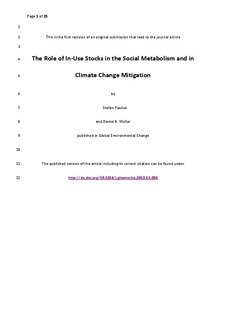The Role of In-Use Stocks in the Social Metabolism and in Climate Change Mitigation
Journal article, Peer reviewed
Permanent lenke
http://hdl.handle.net/11250/2367975Utgivelsesdato
2013Metadata
Vis full innførselSamlinger
Sammendrag
Human well-being includes the use of physical services from buildings, infrastructure, and consumer products. These in-use stocks link the services enjoyed by humans to energy and material consumption. Climate change mitigation requires us to transform current in-use stocks to decouple energy and material throughput from service provision. Assessing the potential environmental benefits of emissions mitigation and other sustainable development strategies requires a solid understanding of in-use stocks and their dynamics.
We identified the different roles of in-use stocks in the social metabolism and showed to what extent they are included in current impact assessment models. We extended state-of-the-art dynamic stock models by including direct and indirect energy demand and greenhouse gas emissions. We applied the new modeling framework to three case studies in the major sectors transportation, buildings, and industry. We assessed the emissions reduction potential of the decoupling strategies energy efficiency, material efficiency, and moderate lifestyle changes.
For the global steel industry and for residential buildings the emissions reduction potential of the above-mentioned strategies was so large that the benchmarks corresponding to the 2 °C climate target could be reached. Decoupling alone might be sufficient to reach the 2 °C benchmarks in some sectors. Considering decoupling next to supply side measures such as new energy technologies may make it easier to consider other objectives than emissions reduction. Decoupling may therefore revitalize the debate about sustainable development because it allows us to loosen the focus on climate change mitigation and put more weight on the economic, social, cultural, and other environmental aspects of sustainability.
